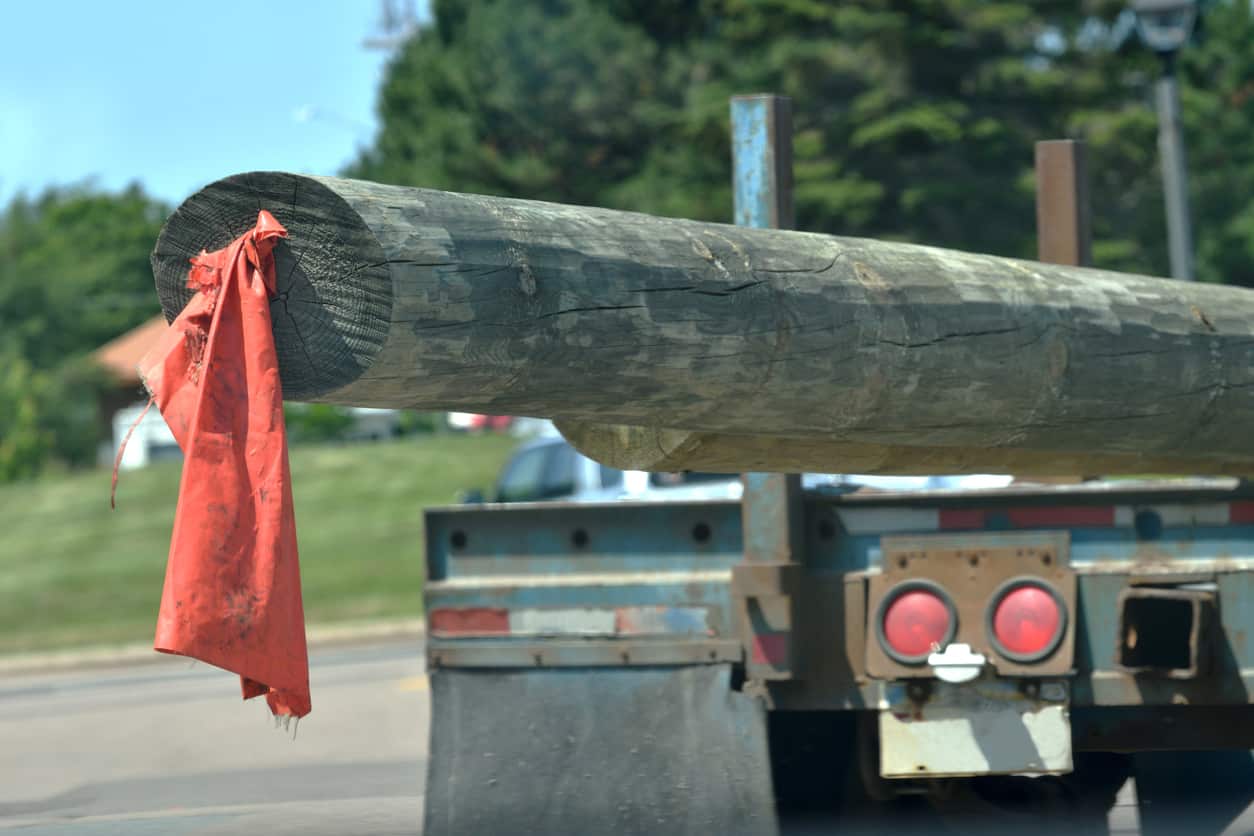The Truth About Truck Load Red Flags Most Drivers Miss [2025 Guide]
Do you know when a red flag for truck loads becomes necessary? Trucks pose unique challenges due to their size, weight, and potential for causing catastrophic accidents. When sharing the road with these massive vehicles, your safety depends on recognizing warning signs that many drivers unfortunately miss.
In 2020 alone, 20,160 traffic fatalities occurred in the United States, with an estimated 4.4 million people sustaining injuries from motor vehicle crashes. Many of these accidents involve commercial vehicles with improperly secured loads. Specifically, overloaded trucks can experience mechanical failures such as tire blowouts or brake malfunctions due to excess weight. Additionally, trucks traveling at high speeds are more likely to roll over, jackknife, or collide with other vehicles. Understanding when you need a red flag on your load isn’t just about following regulations—it’s about preventing these devastating outcomes.
This comprehensive guide will help you identify potentially dangerous truck loads, understand your legal responsibilities, and learn proper flagging techniques to keep yourself and others safe on the road.
Common Red Flags Drivers Often Miss
Spotting hazardous truck loads requires vigilance. Many drivers fail to recognize these red flag for truck loads situations until it’s too late. Here are six critical warning signs you should never ignore:
1. Overhanging cargo without a red flag
Federal regulations mandate that any load extending beyond the sides by more than 4 inches or projecting more than 4 feet from the rear must display red or orange fluorescent warning flags. These flags must be at least 18 inches square and positioned to indicate maximum width. For narrow projections (2 feet or less), one flag is sufficient, while wider loads require two flags.
2. Loose or shifting loads
Improperly secured cargo can shift during transit, dramatically affecting a truck’s stability and control. Watch for loads that appear to be moving or tilting within the truck bed. This dangerous situation often leads to rollovers, jackknife accidents, or debris falling onto the roadway. Moreover, cargo shifting inside trailers can block mirrors or brake lights, limiting driver visibility.
3. No visible warning signs on wide loads
Trucks carrying oversized loads must display warning signs at both front and rear. Furthermore, regulations require flags at all four corners of the load plus additional markers at the widest sections. The absence of these indicators creates serious hazards for passing vehicles unaware of the extra width.
4. Unsecured tarps or straps
Loose or damaged straps, worn chains, or improperly tied-down equipment are disasters waiting to happen. Besides creating balance issues, unsecured items can become deadly projectiles at highway speeds. In fact, even smaller items like tools or construction materials can be thrown from truck beds with devastating force.
5. Missing reflectors or lights at night
While red flags work well during daylight, they become nearly invisible after dark. Consequently, regulations require warning lights for nighttime transportation that remain visible from at least 500 feet away. Some states also mandate flashing, rotating, or strobe lights on vehicles carrying oversized loads.
6. Red flag on back of truck not visible
Even properly placed flags lose effectiveness if they’re dirty, damaged, or obstructed from view. The law requires these warning markers to be clean, in good condition, and positioned at the extreme end of the load to maximize visibility. Nevertheless, many trucks fail to maintain proper flag placement throughout their journey.
Why These Red Flags Are Dangerous
Overlooking a red flag for truck loads can have severe consequences that extend far beyond mere traffic violations. Understanding these dangers helps explain why proper load flagging is so critical on our roadways.
1. Increased risk of road accidents
Improperly flagged loads directly contribute to some of the most catastrophic truck accidents. Rollovers occur primarily when poorly loaded trucks become off-balance, especially on curves or downhill sections. Jackknife accidents happen undoubtedly when imbalanced cargo causes a trailer to swing outward. Notably, brake failures emerge when overloaded vehicles place excessive strain on braking systems. Perhaps most dangerous are lost loads—improperly secured cargo that falls onto roadways, potentially striking other vehicles. Overall, these hazards can lead to crushing injuries, spinal cord damage, traumatic brain injuries, and even wrongful death.
2. Legal consequences for non-compliance
Trucking companies have a legal responsibility to ensure compliance with all federal cargo loading and securement regulations. Violations of these laws can trigger significant penalties. Generally, when an accident occurs, investigators look for specific clues indicating cargo problems—skid marks, damage inside trailers, and evidence of broken tie-downs. Multiple parties may be held liable for damages from an unsecured load, including drivers, loading companies, and trucking firms. Essentially, failing to display proper warning flags creates a clear pattern of negligence that substantially increases legal exposure.
3. Reduced reaction time for other drivers
The human factor remains critical in understanding why flagging matters. According to research, human reaction time typically ranges between 1.2-2.4 seconds for younger drivers, whereas elderly drivers require 1.35-2.7 seconds to respond to hazards. Furthermore, distracted drivers experience significantly delayed response times. Consider this: even a one-second delay can mean the difference between avoiding and causing a collision. Without proper warning flags, other motorists lack the critical advance notice needed to safely respond to oversized or projecting loads.
When Do You Need a Red Flag on a Load?

Image Source: Wilson Kehoe Winingham
Understanding the regulations for red flag for truck loads keeps you safe and compliant. Let’s explore the exact requirements.
1. Federal and state regulations explained
Federal regulation 49 CFR §393.87 clearly outlines warning flag requirements for commercial vehicles. Primarily, these regulations exist to alert other drivers about potential hazards. States often have their own additional requirements that may differ slightly from federal standards. First, check both federal guidelines and specific state regulations before hauling any oversized load, as compliance requirements change at state borders.
2. Length and width thresholds that require flags
You need warning flags whenever your load:
- Extends more than 4 inches beyond the sides of your vehicle
- Projects more than 4 feet beyond the rear
- Exceeds standard legal road width permissions
Some states have stricter requirements—Pennsylvania mandates flags for loads extending more than 3 feet beyond the front.
3. How to fly a flag on a truck properly
Warning flags must be:
- Either red or orange fluorescent in color
- At least 18 inches square (12 inches in some states)
- Clean and in good condition
- Placed at extreme corners of the load
- Securely attached by one corner or displayed on a flag staff
- Visible from at least 500 feet during daylight
4. Who is responsible for securing a load on a truck?
Ultimately, both the driver and employer share responsibility. According to the FMCSA, “It is the responsibility of the motor carrier and the driver to ensure that any cargo aboard a vehicle is properly loaded and secured”. The legal obligation rests primarily with the driver. Fleet operators must ensure employees understand proper load securement techniques.
How to Avoid These Mistakes as a Driver
Preventing red flag for truck loads violations requires systematic approach and attention to detail. Here’s how professional drivers stay compliant and safe:
1. Pre-trip inspection checklist
Thorough pre-trip inspections take approximately 15-30 minutes but prevent costly roadside failures. Primarily, drivers must:
- Check tires for proper inflation and tread depth (at least 0.125″)
- Inspect all cargo securement devices and tie-downs
- Verify that lights, reflectors, and warning flags are clean and functional
- Confirm that all load dimensions are properly documented
The FMCSA requires at least one inspection logged in your hours of service daily.
2. Using proper red flag placement
Position flags at the extreme ends of any projecting load. Each flag must be secured by one corner or displayed on a flag staff. Alternatively, inspect flags regularly throughout your journey, as dirt and damage decrease visibility.
3. Choosing the right materials for securing cargo
Instead of bungee cords, use ratchet straps rated for appropriate weights. Indeed, straps with working load limits of at least half the cargo weight provide better security. Corner protectors placed over sharp edges prevent damage to both cargo and strapping materials.
4. Reporting unsafe loads on the road
If you spot dangerous cargo on highways, immediately contact the FMCSA through their National Consumer Complaint Database. Ultimately, reporting hazards helps prevent accidents and improve industry safety standards.
Conclusion
Understanding red flag for truck loads requirements serves as a critical safety measure for both professional drivers and everyday motorists. Though often overlooked, these warning indicators significantly reduce accident risks when properly implemented. Undoubtedly, the consequences of ignoring proper load flagging extend far beyond simple traffic violations – they can lead to catastrophic accidents, severe injuries, and substantial legal penalties.
First and foremost, your vigilance matters when spotting potential hazards such as overhanging cargo, shifting loads, or unsecured tarps. Additionally, familiarizing yourself with federal and state regulations ensures you remain compliant while transporting oversized materials. Professional drivers must conduct thorough pre-trip inspections, whereas all road users should report unsafe loads when spotted.
Safety on our highways depends on everyone’s participation. Therefore, recognizing these warning signs not only protects you but also safeguards fellow motorists. The extra minutes spent securing loads properly and displaying appropriate red flag for truck loads warnings ultimately save lives. Remember that responsibility falls on both individual drivers and transportation companies to maintain these essential safety standards.
Your awareness of these warning signs transforms you from a passive road user into an active participant in preventing devastating accidents. After all, road safety relies on mutual vigilance and respect for regulations designed to protect everyone sharing our highways.
FAQs
Q1. When is a red flag required on a truck load?
A red flag is required when a load extends more than 4 inches beyond the sides of the vehicle or projects more than 4 feet beyond the rear. Some states may have stricter requirements, so it’s important to check both federal and state regulations before hauling any oversized load.
Q2. What are the proper specifications for warning flags on trucks?
Warning flags must be either red or orange fluorescent in color, at least 18 inches square (12 inches in some states), clean and in good condition. They should be placed at the extreme corners of the load, securely attached by one corner or displayed on a flag staff, and visible from at least 500 feet during daylight.
Q3. Who is responsible for securing a load on a truck?
Both the driver and the employer share responsibility for securing loads. The driver has the primary legal obligation to ensure that cargo is properly loaded and secured. Fleet operators must also ensure their employees understand proper load securement techniques.
Q4. What are some common red flags that drivers often miss?
Common red flags include overhanging cargo without proper warning flags, loose or shifting loads, missing warning signs on wide loads, unsecured tarps or straps, missing reflectors or lights at night, and improperly placed or maintained red flags on the back of the truck.
Q5. How can drivers avoid mistakes related to load flagging?
Drivers can avoid mistakes by conducting thorough pre-trip inspections, using proper red flag placement, choosing appropriate materials for securing cargo, and reporting unsafe loads on the road. Regular checks throughout the journey and staying updated on federal and state regulations are also crucial for maintaining compliance and safety.

Leave a Reply